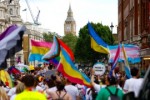Raj Tawney, right, attends the U.S Open at Arthur Ashe Stadium with his brother and father, who taught himself to play tennis after moving to New York.
Last week, when Donald Trump mispronounced Jimmy Carter’s name by referring to the former president as Jimmy Connors, the legendary retired tennis pro, my dad called to tell me. We both laughed. After all, it had been a long time since Trump and Connors were mentioned in the same conversation under our roof.
Three decades earlier, I’d sit on the floor in between my Dad’s lap as we watched 39-year-old Connors’ historic 1991 semifinal U.S. Open run on TV. That same year, Trump attended the tournament with his then-fiancee Marla Marples. I can’t recall if he was at one of Connor’s matches but, during the coverage, whenever the camera would flash to him, I’d ask my dad who that “funny-looking man” was.
“He’s a businessman,” Dad would reply.
Advertisement
Article continues below this ad
“Why does he get to be there?” I’d ask.
“Because he’s rich.”
Trump, like many wealthy New Yorkers, has enjoyed attending the open over the years. It was an opportunity to be seen. Whether or not they liked tennis was secondary. For my Mumbai, India,-born dad, however, tennis was a sport he fell in love with and taught himself to play after he arrived in New York in 1976.
Dad quickly picked up tennis after having been a local ping-pong champion in India and a recreational cricket player while attending college in London. When he arrived stateside for graduate school and engineering work, he taught himself tennis as an opportunity to integrate into his community and make friends in his new homeland. He’d already idolized American pros like Connors and Arthur Ashe ever since their now-legendary Wimbledon final a year earlier, in 1975, when Ashe finally defeated Connors after losing to him three times prior. Though very different people, they were both passionate about the game.
Both Ashe and Connors attended UCLA, less than 10 years apart, and won NCAA titles for their teams before going professional. While still a student, the rising star Ashe was asked to join the U.S. Davis Cup team — a position he accepted proudly, serving as the first Black player to do so. When Ashe met Connors at Wimbledon a decade later, the two had already been feuding as Connors, a lone wolf, refused to join the Davis Cup team and the newly formed Association of Tennis Professionals, co-founded by Ashe in 1972. Connors was also suing Ashe at the time due to Ashe referring to Connors as “unpatriotic” for not joining the Davis Cup. Ashe wore the now-iconic Davis Cup warm-up jacket during the final with Connors and became the first Black male player to win the tournament –– an important feat for the progress of American tennis, too.
Advertisement
Article continues below this ad
Though Dad lived in Queens for years, just down the road from where the U.S. Open is held –– in Forest Hills then Flushing Meadows –– he was always too busy working to attend the tournament. But that didn’t stop him from watching on TV –– a tradition he continued with me and my brother Ravi, along with teaching us the sport once he moved us out to Long Island for a better life. For my dad, joining school teams, leagues and earning scholarships were less important. He hoped for us to adopt a sport to make it part of our lives, to use it as a navigational tool in a world not always welcoming to people who had foreign-sounding names and looked different than the American standard.
By the time Ravi and I began learning the game in the early ’90s, Ashe had already passed away from AIDS-related pneumonia in 1993 and had stopped playing years earlier due to suffering a heart attack in 1978, though his writing and activism influenced me in other ways over the years. Connors, however, played until 1996, and one evening, Dad finally got to see him play live. He took Mom, Ravi and me into the city to Madison Square Garden where an exhibition match was being held. We sat in the very last row of the arena. I could only remember tiny ants hitting a dot back and forth, but I was more so fixated on Dad’s gleaming smile. He didn’t care if he could barely see the match –– just sharing the same room as one of his idols was enough.
As Dad worked his way up in his career, and we could afford U.S. Open tickets, he’d take Ravi and me every couple of years. Sure, we always sat high up in the stands at Arthur Ashe Stadium but we witnessed the greatness of Serena Williams, Roger Federer, Novak Djokovic and Andy Murray together. Most of the time, we prefer watching lesser-known players on the outer courts as new hopefuls ascend in their journeys. In his thick accent, Dad still has a difficult time pronouncing some of the players’ names. He laughs as he makes attempts to say Radacanu or Alcaraz –– he usually just refers to them as Emma and Carlos. One name he’s never failed at pronouncing is Jimmy Connors.
Raj Tawney is an essayist and journalist whose work largely reflects his New York-area upbringing and multiracial identity. His debut memoir “Colorful Palate: A Flavorful Journey Through a Mixed American Experience” was recently released. His forthcoming middle-grade novel is “All Mixed Up.”
Trump confused Jimmy Carter and Jimmy Connors. It was a nostalgic rush
 26
26
 1
17.05.2024
1
17.05.2024
Raj Tawney, right, attends the U.S Open at Arthur Ashe Stadium with his brother and father, who taught himself to play tennis after moving to New York.
Last week, when Donald Trump mispronounced Jimmy Carter’s name by referring to the former president as Jimmy Connors, the legendary retired tennis pro, my dad called to tell me. We both laughed. After all, it had been a long time since Trump and Connors were mentioned in the same conversation under our roof.
Three decades earlier, I’d sit on the floor in between my Dad’s lap as we watched 39-year-old Connors’ historic 1991 semifinal U.S. Open run on TV. That same year, Trump attended the tournament with his then-fiancee Marla Marples. I can’t recall if he was at one of Connor’s matches but, during the coverage, whenever the camera would flash to him, I’d ask my dad who that “funny-looking man” was.
“He’s a businessman,” Dad would reply.
Advertisement
Article continues below this ad
“Why does he get to be there?” I’d ask.
“Because he’s rich.”
Trump, like many wealthy New Yorkers, has enjoyed attending the open over the years. It was an opportunity to be seen. Whether or not they liked tennis was secondary. For my Mumbai, India,-born dad, however, tennis was a sport he fell in love with and........
© San Francisco Chronicle
 visit website
visit website






















 Toi Staff
Toi Staff Mohamad Elmasry
Mohamad Elmasry Maoz Inon
Maoz Inon Belen Fernandez
Belen Fernandez Brahma Chellaney
Brahma Chellaney Tarik Cyril Amar
Tarik Cyril Amar Petra Lesjak Tušek
Petra Lesjak Tušek Gideon Levy
Gideon Levy Rachel Marsden
Rachel Marsden Julie Bindel
Julie Bindel
